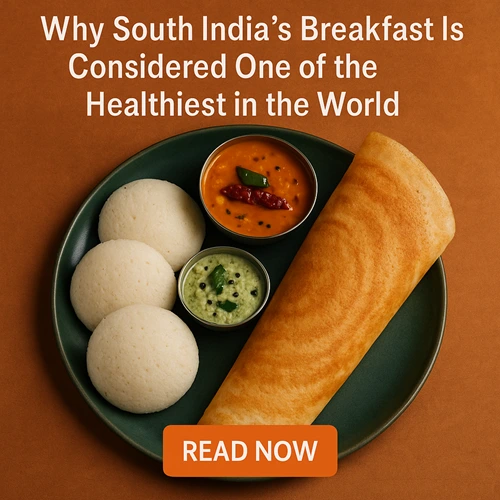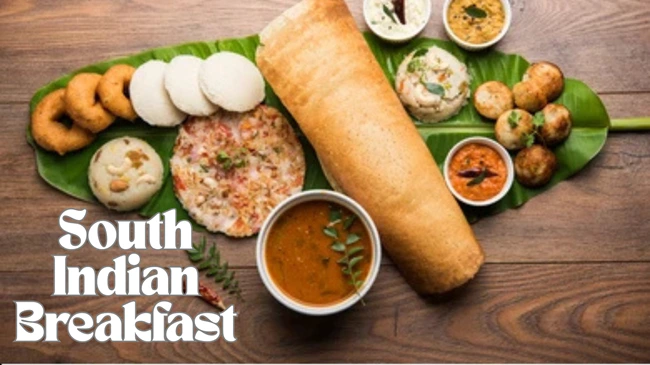By a True Food Lover Who Swears by That Steamy Idli and Spicy Chutney Combo
There’s something magical about waking up to the aroma of sizzling mustard seeds, curry leaves, and steaming hot idlis in a South Indian home. If you’ve ever tasted a traditional South Indian breakfast, chances are you’ve never forgotten the experience. But it’s not just the taste that lingers — it’s the feeling of lightness, satisfaction, and nourishment that stays with you. While the world may swear by oats, smoothies, and avocado toast, health enthusiasts and nutritionists often turn to the southern tip of India for a more time-tested and holistic approach to the most important meal of the day.
From fermented delights like idli and dosa to wholesome bowls of pongal and upma, South India’s breakfast is not only packed with flavor but also deeply rooted in health, sustainability, and balance. But what exactly makes it so special?
Let’s dive fork-first into the fascinating world of South Indian breakfast, and explore why they’re hailed globally as one of the healthiest ways to kickstart your day.

Benefits Of South Indian Breakfast Are :
1. The Power of Fermentation: Idli, Dosa & Beyond
Fermentation is at the heart of many South Indian breakfast staples. Foods like idli, dosa, and uttapam are made using a batter of rice and urad dal (black gram), fermented overnight.
Why it’s good for you:
- Boosts gut health: Fermentation promotes the growth of good bacteria, essential for digestion and immunity.
- Easier nutrient absorption: Fermentation breaks down anti-nutrients, allowing your body to absorb more iron, calcium, and vitamins.
- Naturally low-fat & gluten-free: These foods are light on the stomach but high on satiety.
Imagine biting into a soft, fluffy idli dipped in coconut chutney or crisp dosa oozing with ghee. You’re not just eating — you’re feeding your body with live cultures, fiber, and clean energy.
2. Plant-Based Goodness in Every Bite
A traditional South Indian breakfast is predominantly vegetarian and often vegan-friendly. Unlike Western breakfasts heavy on processed meats and dairy, the South Indian plate draws its strength from grains, legumes, spices, and vegetables.
Common Ingredients:
- Rice and lentils – protein-packed, fiber-rich, and naturally gluten-free
- Coconut – full of healthy fats and antioxidants
- Curry leaves, mustard seeds, ginger, green chilies – spices that boost immunity and metabolism
- Vegetables – carrots, beans, onions, tomatoes, and more, sautéed into dishes like upma, vegetable uthappam, or rava kichadi
This plant-forward approach ensures that you’re getting complex carbohydrates, quality protein, and essential micro-nutrients without burdening your digestive system.
3. Balanced Macronutrients = Sustained Energy
Ever wondered why a South Indian breakfast keeps you full but doesn’t make you sluggish? The secret lies in its perfect balance of carbs, proteins, and fats.
Take Ven Pongal, for example — a comforting dish made with rice and moong dal, tempered with ghee, pepper, cumin, and ginger. It combines:
- Carbs from rice for energy
- Proteins from lentils for satiety
- Healthy fats from ghee to aid digestion and brain function
Compare that to sugary cereals or greasy hash browns, and the South Indian plate wins hands down for both health and satisfaction.
4. Ayurveda-Backed Ingredients & Cooking Methods
South Indian breakfasts are unintentionally Ayurvedic. The cooking techniques, ingredient pairings, and even meal timings align with ancient wellness practices.
- Ginger, turmeric, cumin, and asafoetida (hing) help in balancing doshas (vata, pitta, kapha)
- Steaming is the preferred method — preserving nutrients while being gentle on the stomach
- Meals are warm, freshly prepared, and seasonal, supporting digestive fire (agni)
This isn’t just food — it’s preventive healthcare served on a banana leaf.
5. Timed to Perfection: A Hearty Start, Not a Heavy One
A key reason South Indian breakfasts are healthy is because they follow an ideal circadian rhythm — eating the most substantial meal early in the day when digestion is strongest.
Unlike late brunches with fried meats and cheeses, South Indian families eat freshly prepared, light-yet-nutritious dishes by 8-9 AM, setting the tone for steady energy, sharper focus, and better gut health throughout the day.
6. Homemade, Fresh & Preservative-Free
The best part? No packaged cereals, no preservatives, no synthetic ingredients.
Even the chutneys and sambar served with dosas or vadas are made from scratch — using roasted dals, fresh coconut, tamarind, curry leaves, and hand-ground spices. There’s zero dependency on store-bought flavoring or additives.
Food is cooked daily, usually with locally sourced and seasonal produce, making it eco-friendly and easier to digest.
7. Coconut, Curry Leaves & Other Superfoods on the Daily
In South Indian kitchens, superfoods aren’t trends — they’re tradition.
- Coconut: Rich in medium-chain triglycerides (MCTs), aids in fat metabolism, boosts brain health
- Curry Leaves: High in antioxidants, good for hair and digestion
- Tamarind: A natural detoxifier and a good source of magnesium
- Mustard Seeds: Anti-inflammatory and packed with selenium
- Urad Dal & Moong Dal: Powerful plant-based proteins rich in iron and potassium
When combined, these form a nutrient powerhouse that no multivitamin pill can replicate.
8. Mindful Eating Practices & Cultural Connection
Eating in a traditional South Indian home is an experience — you sit down, eat with your hands, savor each bite, and end with a small banana or a piece of jaggery.
There’s a sense of mindfulness, gratitude, and respect for food that’s ingrained in the culture. No grabbing breakfast on the go. No mindless munching while scrolling. This emotional and cultural connection with food is a key contributor to overall well-being.
9. Global Appeal with Local Wisdom
Today, nutritionists and chefs across the world are embracing dishes like millet dosa, oats idli, quinoa upma, and vegetable uthappam for their nutritional value.
You’ll find South Indian breakfast options on menus in:
- Wellness retreats in Bali
- Vegan cafes in New York
- Fitness resorts in Europe
It’s the perfect blend of ancient food wisdom and modern health consciousness.
10. Variety That Never Gets Boring
Who said healthy food has to be boring? South India offers an endless variety of breakfast items that rotate daily, weekly, and seasonally.
Here’s a short list of beloved options:
- Idli, Dosa, Uttapam – with a rainbow of chutneys and sambar
- Pongal – creamy and peppery
- Upma – savory semolina delight
- Appam with Stew – Kerala’s soul food
- Puttu and Kadala Curry – rice flour and black chana combo
- Adai – lentil crepe with a spicy edge
- Kozhukattai – steamed rice dumplings
This wide variety ensures you never get bored, and your body enjoys a range of nutrients and textures daily.
Final Thoughts: South Indian Breakfast — Where Taste Marries Health
In a world racing behind food fads and quick fixes, South Indian breakfasts have stood the test of time for all the right reasons. They’re simple, soulful, scientifically beneficial, and deeply rooted in tradition. Whether you’re a gym-goer, a yoga practitioner, a busy professional, or just someone who loves good food — this cuisine offers the perfect start to your day.
So the next time you’re wondering what to eat in the morning — ditch the sugary cereals and say yes to a plate of idli-sambar, a bowl of pongal, or a crisp rava dosa.
Trust me, your taste buds, gut, and heart will thank you.
Quick Takeaways
| Feature | Why It’s Healthy |
|---|---|
| Fermentation | Boosts digestion & gut health |
| Plant-based | Naturally low in fat & high in fiber |
| Balanced macros | Sustained energy, no crashes |
| Ayurveda-friendly | Uses spices that aid metabolism |
| Fresh & seasonal | No preservatives or packaged foods |
| Variety | Keeps meals exciting and nutrient-diverse |
FAQs – South Indian Breakfast & Its Health Benefits
Q1. Why is South Indian breakfast considered healthy?
South Indian breakfast is healthy due to its balanced combination of complex carbs, plant-based protein, and healthy fats. Most dishes are fermented, steamed, or lightly sautéed, making them easy to digest and nutrient-rich. The cuisine incorporates spices and herbs like turmeric, curry leaves, ginger, and mustard seeds, which have proven anti-inflammatory and digestive benefits. It’s also free from processed ingredients and is predominantly vegetarian or vegan-friendly.
Q2. Is idli good for weight loss?
Yes, idlis are excellent for weight loss. They are steamed, low in calories, and made from fermented rice and urad dal, making them light yet filling. The fermentation improves digestion and enhances nutrient absorption. Idlis provide energy without adding unhealthy fats, making them a great choice for those on a weight loss journey — especially when paired with coconut chutney or sambar.
Q3. Can I eat dosa regularly if I’m diabetic?
Plain dosa, especially if made with brown rice or millets, can be consumed in moderation by diabetics. Pairing dosa with protein-rich sambar or coconut chutney can help control the glycemic response. However, avoid masala dosa with potato fillings or using excessive ghee or oil. Opt for ragi dosa or green gram dosa (pesarattu) for better blood sugar management.
Q4. Is South Indian breakfast suitable for vegans?
Absolutely. Most South Indian breakfasts are naturally vegan. Staples like idli, dosa, upma, pongal, and appam do not contain dairy or animal products. Coconut-based chutneys and vegetable-based stews are common accompaniments. Just make sure to avoid dishes prepared with ghee or curd if you’re following a strict vegan diet, or ask for plant-based substitutes.
Q5. What is the healthiest South Indian breakfast dish?
While most dishes are healthy, some of the top contenders include:
- Idli – steamed, light, and gut-friendly
- Vegetable Upma – high in fiber and micronutrients
- Ven Pongal (moong dal + rice) – comforting and protein-rich
- Ragi Dosa – high in calcium and good for diabetics
- Pesarattu – made from green gram, rich in protein and fiber
Each of these dishes supports digestion, energy levels, and metabolic health when consumed as part of a balanced diet.
Q6. Is South Indian breakfast too high in carbs?
It’s true that many South Indian dishes are carbohydrate-based, but they use complex carbs like rice, lentils, millets, and semolina — not refined sugars or flours. These complex carbohydrates release energy slowly, keeping you fuller for longer and avoiding blood sugar spikes. When combined with dal-based sambar or protein-rich chutneys, the meal becomes nutritionally balanced.
Q7. Can South Indian breakfast be included in a keto diet?
Traditional South Indian breakfasts are not keto-friendly due to their high carb content. However, keto versions can be made:
- Cauliflower rice upma
- Almond flour dosa
- Egg uthappam (fusion)
These require non-traditional ingredients but allow keto followers to enjoy South Indian flavors.
Q8. Is South Indian breakfast good for kids?
Yes, it’s perfect for children. It’s soft, easy to chew, and packed with nutrients. Dishes like idli, pongal, and vegetable upma are ideal for toddlers and school-going children. They’re rich in energy, support brain development, and promote healthy digestion — all without any artificial flavors or preservatives.
Q9. Is eating South Indian breakfast daily healthy?
Yes, eating South Indian breakfast daily is healthy, especially when there’s variety and moderation. Rotate between idlis, dosas, pongal, upma, and other items. Incorporating millets, vegetables, and different lentils keeps the meals nutritionally diverse and avoids dietary monotony.
Q10. How can I make my South Indian breakfast even healthier?
Here are a few tips to boost the health factor:
- Use millets or brown rice in place of white rice
- Steam instead of fry (avoid deep-fried medu vadas regularly)
- Add more vegetables to upma, dosa fillings, or uttapam
- Use less oil or opt for cold-pressed oils
- Pair your meal with a cup of herbal tea or buttermilk
Even traditional dishes can be tweaked to suit your dietary needs while keeping the soul of South Indian breakfast alive.
Q11. What are some lesser-known South Indian breakfast dishes to try?
If you’re bored of the regular idli-dosa combo, try:
- Kozhukattai – steamed rice flour dumplings with coconut
- Rava Kichadi – soft, buttery, and filled with vegetables
- Adai Avial – lentil-based pancake with a coconut-veggie curry
- Appam with stew – Kerala’s coconut milk-based delicacy
- Puttu with kadala curry – a Kerala classic made from rice flour and black chickpeas
These are nutritionally dense, delicious, and unique, offering a whole new dimension to your morning plate.
Q12. Is sambar healthy?
Yes, sambar is extremely healthy. Made with toor dal (pigeon peas), seasonal vegetables, and tempered with mustard seeds, curry leaves, and asafoetida, it’s rich in:
- Plant protein
- Dietary fiber
- Essential vitamins (A, C, B-complex)
- Minerals like iron and potassium
It supports digestion, reduces inflammation, and is an excellent low-fat, high-nutrient side dish that pairs with almost every South Indian breakfast item.
If you’re ready to turn your mornings into a ritual of health, tradition, and flavor, South Indian breakfasts are your new best friend!
Read More About Interesting Indian Food & Recipe on Popnewsblend.com.

Hi, I’m Prashant Jain — a curious soul, storyteller, and content creator at heart.I’ve always been drawn to the world of entertainment, travel, sports, health & lifestyle — not just as a writer, but as someone who genuinely lives these experiences. Whether I’m binge-watching the latest OTT series, exploring offbeat spiritual destinations in India, or diving deep into wellness routines and cricket match insights, I love sharing what I discover with like-minded readers.
PopNewsBlend is my way of blending personal journeys with meaningful stories — ones that inform, inspire, and keep you ahead of the curve. Everything I write comes from real observations, hands-on experiences, and a deep passion for understanding the world around us.
Discover more from Popnewsblend
Subscribe to get the latest posts sent to your email.








Pingback: Indian Food Rivalry : Paratha vs Dosa vs Kadhi & More
Pingback: India’s Favorite Monsoon Breakfast & Snacks – Chai, Pakoras & More Rainy Day Delights
Pingback: North Indian vs. South Indian Breakfasts – A Delicious Comparison